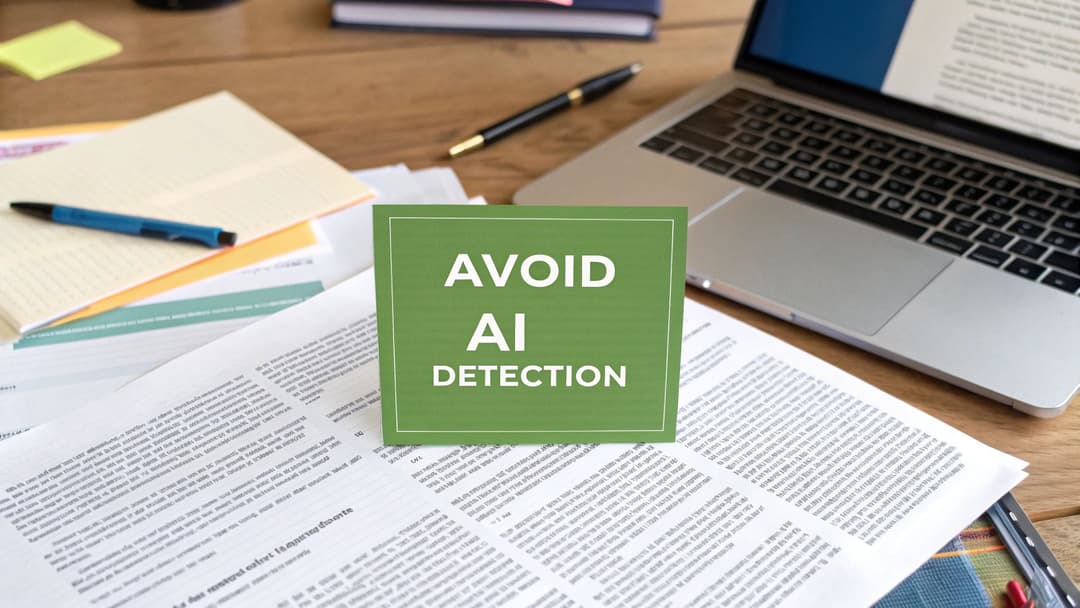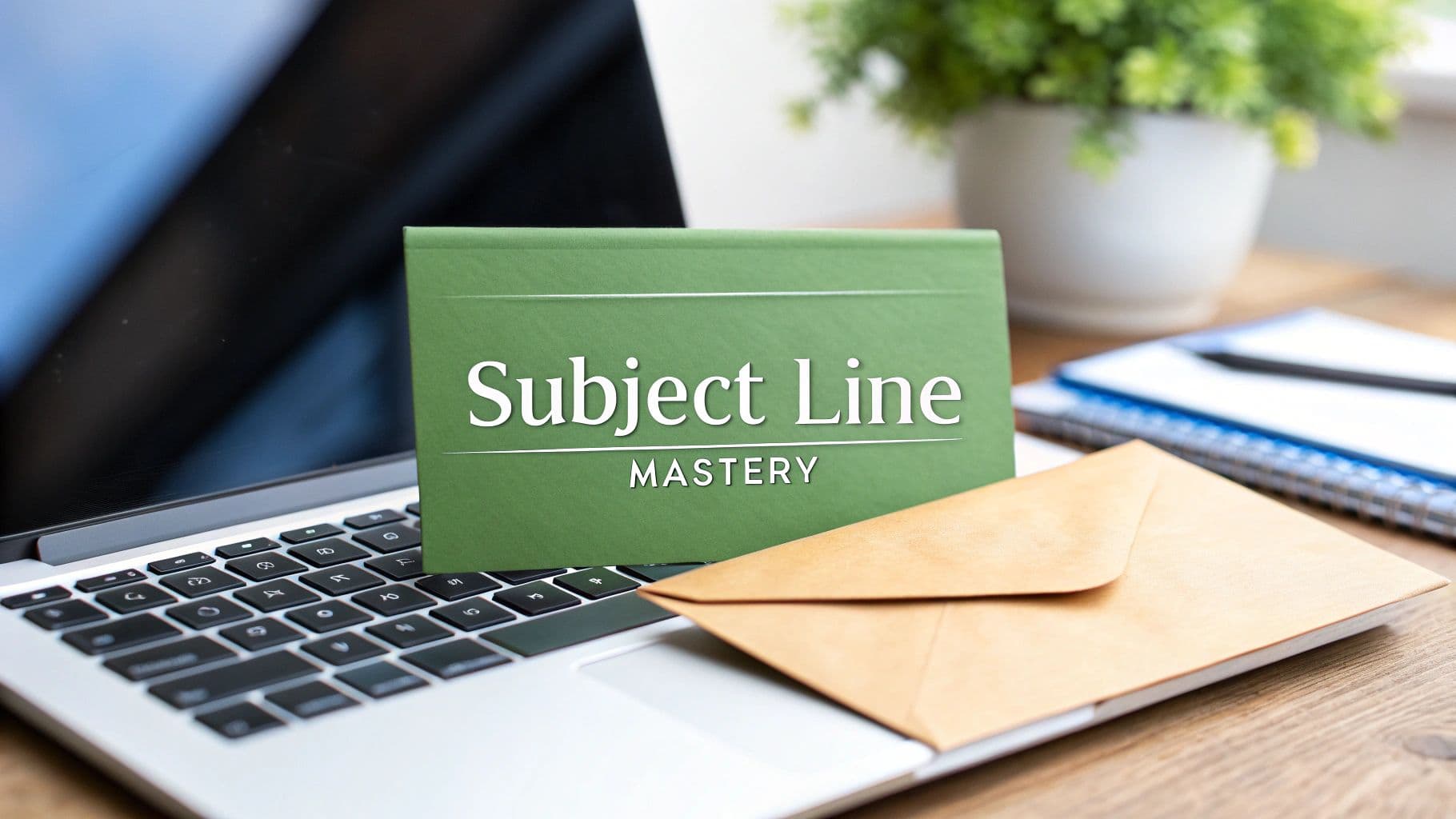
8 Email Subject Line Best Practices for 2025
August 27, 2025
Your email subject line is the gatekeeper to your content. In an inbox overflowing with promotions, newsletters, and notifications, it's the single most critical factor determining whether your message gets opened or ignored. A weak subject line renders even the most brilliantly crafted email invisible, essentially wasting all the effort put into the message itself. This guide cuts through the noise, providing a definitive list of email subject line best practices designed for the modern marketing landscape.
We'll move beyond generic advice to deliver actionable strategies that you can implement immediately. You will learn how to leverage psychological triggers like urgency and curiosity, master the technical nuances of spam filters, and effectively use A/B testing to find what truly resonates with your audience. This article provides a clear roadmap for crafting compelling subject lines that not only stand out but also drive results.
Prepare to transform your subject lines from forgettable text into powerful conversion drivers that command attention and compel your audience to click. For a deeper dive into concrete examples that can boost your conversions, explore these 7 effective email subject lines for sales. Now, let's explore the essential practices that will unlock your inbox potential.
1. Keep Subject Lines Short and Concise (30-50 characters)
In the world of email marketing, brevity is a powerful tool. One of the most fundamental email subject line best practices is to keep your message short, ideally between 30 and 50 characters. This isn't just a stylistic choice; it's a strategic necessity driven by how people read their emails today. With over 40% of emails now opened on mobile devices, where screen space is limited, your subject line is often cut off after just 30-40 characters.
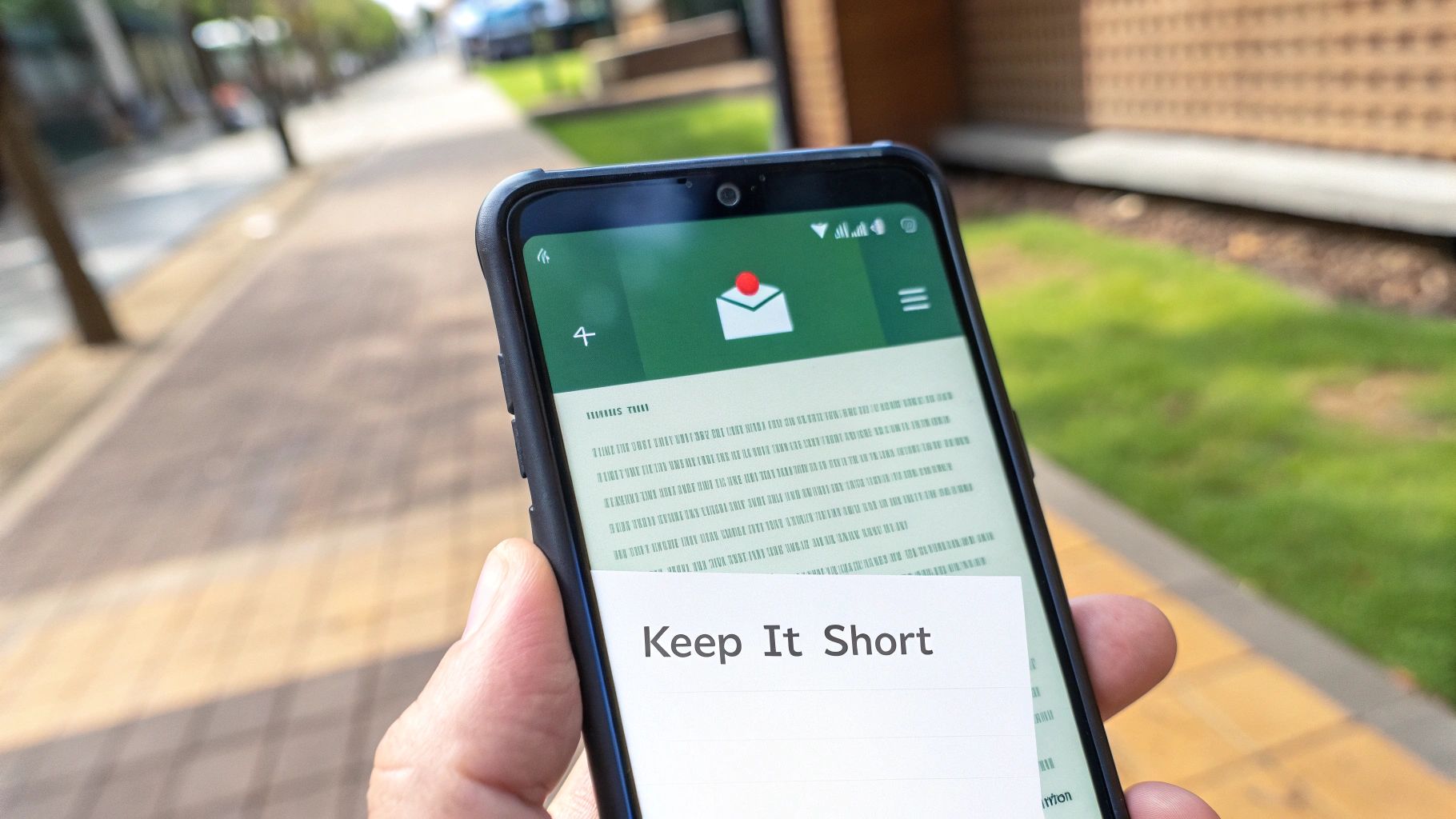
A concise subject line ensures your entire message is visible at a glance, no matter the device or email client. This immediate clarity captures attention in a crowded inbox and communicates your core value proposition before the recipient even opens the email.
Why This Approach Works
Research from industry leaders like Mailchimp and HubSpot consistently shows that shorter subject lines correlate with higher open rates. The primary benefit is improved mobile readability. A truncated subject line can confuse readers or, worse, make your email look like spam, leading them to delete it without a second thought. By keeping it brief, you respect the recipient's time and ensure your key message lands effectively.
Consider these powerful, short examples:
- Nike: 'Your order has shipped ✓' (25 characters)
- Spotify: 'Your 2023 Wrapped is here' (28 characters)
- Airbnb: 'Tokyo adventure awaits' (23 characters)
Actionable Tips for Implementation
Here’s how to put this best practice into action:
- Front-load the important words. Place the most compelling information, like a discount or a key benefit, at the very beginning of the subject line. This guarantees it will be seen even if the rest is cut off.
- Eliminate filler words. Remove unnecessary words such as 'the', 'and', 'or', and 'that'. Be ruthless in your editing to get straight to the point.
- Use testing tools. Before sending, run your ideas through a tool like CoSchedule's Email Subject Line Tester. It analyzes character count, word choice, and other factors to predict performance.
- Test across different devices. Always send a test email to yourself and check how the subject line appears on various mobile devices (iOS, Android) and desktop clients (Gmail, Outlook) to avoid unpleasant surprises.
2. Personalization Using Recipient's Name and Data
Addressing a subscriber by their name is one of the oldest yet most effective email subject line best practices. Personalization goes beyond a simple name drop; it involves leveraging specific customer data like their location, past purchases, or browsing history to create a subject line that feels uniquely tailored. This strategy transforms a mass email into a one-to-one conversation, making the recipient feel seen and valued.
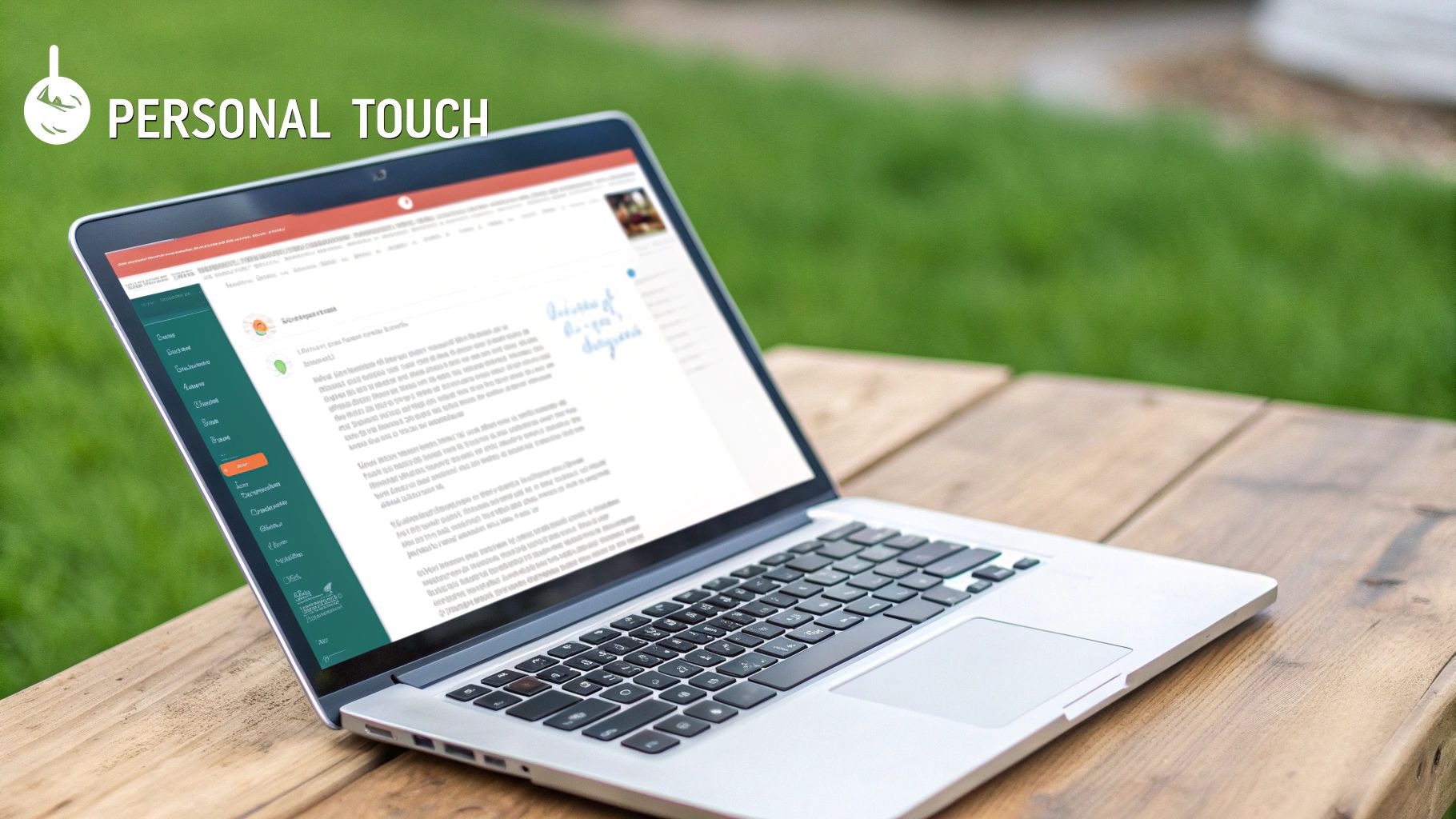
A personalized subject line immediately signals that the content inside is relevant to the individual. By demonstrating that you understand their needs and preferences, you build trust and significantly increase the likelihood of them opening your email to see what’s inside.
Why This Approach Works
Studies consistently show that personalized subject lines can boost open rates by as much as 26%. The core benefit is increased relevance. When a recipient sees their name or a reference to a recent action, their brain flags the email as important, cutting through the noise of generic promotional messages. This technique, popularized by data-driven companies like Amazon and Netflix, makes subscribers feel like insiders rather than just another number on a list.
Consider these highly effective personalized examples:
- Amazon: 'John, your saved items are on sale'
- Uber: 'Sarah, ride to work for $8'
- Starbucks: 'Mike, your usual order + free pastry'
Actionable Tips for Implementation
Here’s how to put this best practice into action:
- Use first names for a friendly tone. Addressing someone by their first name, like 'Hi Sarah,' feels more conversational and less formal than using their full name.
- Combine name with other data. Go a step further by including their location, a recent purchase, or even local weather data. For example: 'Big savings in Boston this weekend, Kate!'
- Always have fallback content. Ensure you have a default value (like 'Valued Customer') set up for contacts who are missing a name or other data fields to avoid awkward blank spaces. To dive deeper into this topic, explore some insights on what content personalization is.
- A/B test personalization. Don't assume personalization always wins. Test a personalized subject line against a compelling, non-personalized one to see which performs better with your specific audience.
3. Create Urgency and Scarcity
One of the most potent psychological triggers you can leverage in an email subject line is the fear of missing out (FOMO). Creating urgency and scarcity involves using time-sensitive language or highlighting limited availability to motivate subscribers to act immediately. This technique is a cornerstone of effective email subject line best practices, turning passive readers into active customers by making the cost of inaction feel greater than the effort of clicking.
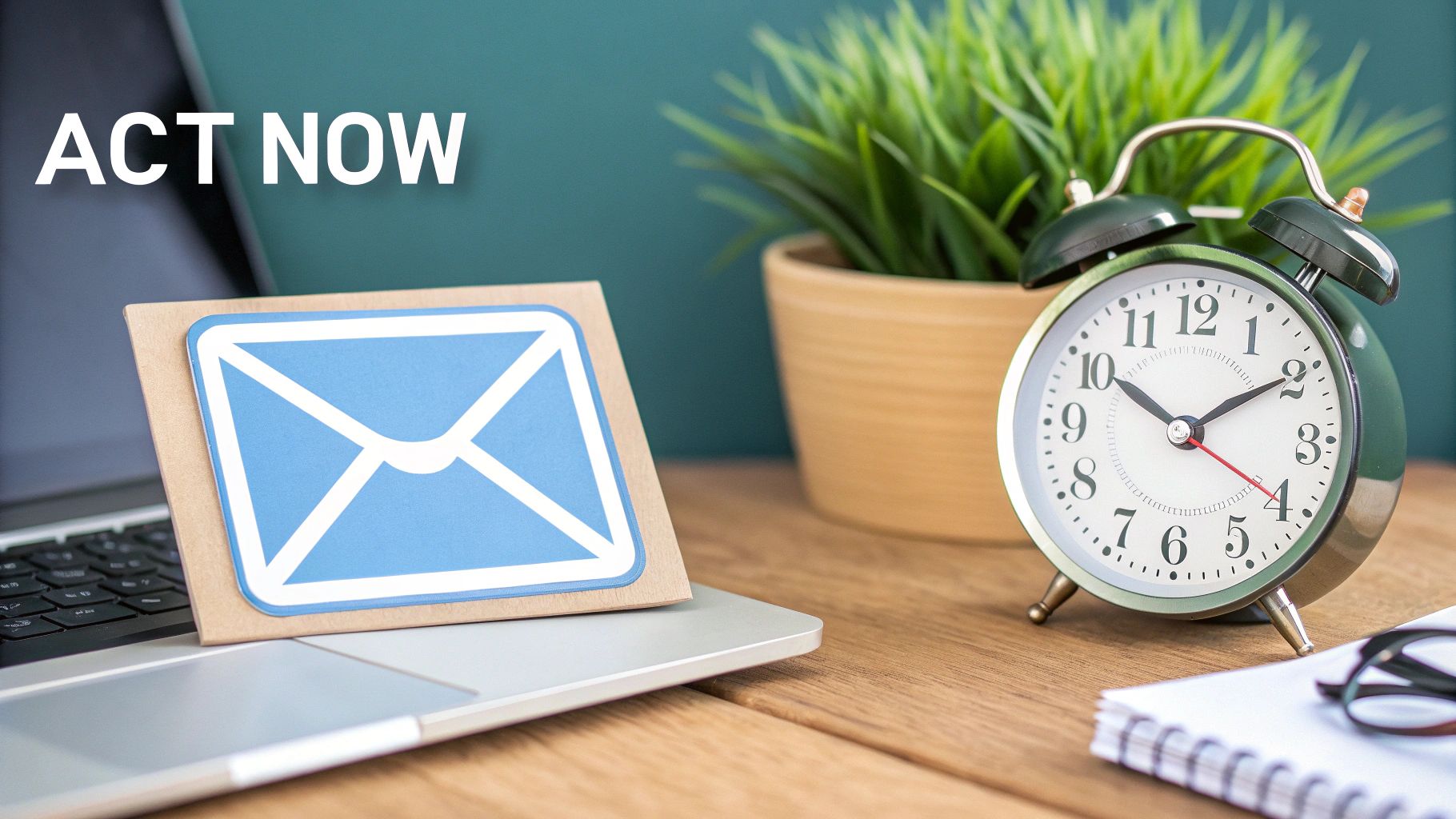
This approach is highly effective for sales, promotions, and event-based communications where a clear deadline or limited inventory exists. It taps into the basic human desire to avoid loss and secure exclusive opportunities, prompting recipients to prioritize your email in a crowded inbox.
Why This Approach Works
Urgency and scarcity work by creating a sense of exclusivity and immediate value. When a subscriber believes an offer is about to disappear, it forces a quick decision. This psychological nudge can dramatically increase open rates and click-through rates, as demonstrated by e-commerce giants like Amazon and daily deal platforms like Groupon. The key is to frame the offer not just as a benefit but as a fleeting opportunity that will soon be lost.
Consider these compelling examples from major brands:
- Booking.com: '2 rooms left at this price!' (Scarcity)
- Groupon: 'Last chance: 50% off expires tonight' (Urgency)
- Eventbrite: 'Only 5 tickets remaining' (Scarcity)
Actionable Tips for Implementation
Here’s how to effectively create urgency and scarcity in your subject lines:
- Be specific and genuine. Vague urgency erodes trust. Instead of "Limited time only," use "Offer ends at midnight." Your scarcity must be based on real constraints, like actual inventory levels or seat availability.
- Use action-oriented language. Combine scarcity with strong verbs. Words like 'ends,' 'expires,' 'final,' 'last chance,' and 'now' signal that immediate attention is required.
- Combine with a clear benefit. Tie the urgency directly to the value proposition. For example, "Final hours to get 25% off" is more powerful than just "Sale ending soon."
- Don't overuse it. If every email is urgent, none of them are. Reserve this tactic for genuinely time-sensitive offers to maintain its impact and avoid fatiguing your audience.
4. Ask Compelling Questions
Asking a question in your subject line is a proven technique to pique curiosity and drive engagement. This approach transforms a passive statement into an active invitation, prompting the recipient to mentally participate before they even open the message. By creating an "information gap," a well-crafted question makes the reader feel a natural urge to click and discover the answer, boosting open rates significantly.

This method makes your email feel more like the start of a one-on-one conversation rather than a generic broadcast. It’s a core component of effective email subject line best practices because it taps directly into human psychology, leveraging our innate desire for answers and resolution.
Why This Approach Works
Question-based subject lines are highly effective because they spark immediate curiosity. Unlike a declarative statement, a question demands an answer and creates a sense of intrigue. This tactic was famously popularized by companies like BuzzFeed with their viral quizzes and has since been adopted by educational platforms and financial services to engage users on a deeper, more personal level. It interrupts the monotonous flow of a crowded inbox and makes your email stand out.
Consider these powerful, question-based examples:
- BuzzFeed: 'Which Disney princess are you?'
- MasterClass: 'Ready to cook like Gordon Ramsay?'
- Mint: 'Want to save $500 this month?'
Actionable Tips for Implementation
Here’s how to put this best practice into action:
- Make questions relevant. Frame your question around a known pain point or interest of your audience. A relevant question shows you understand their needs and are offering a valuable solution.
- Avoid simple yes/no answers. Craft questions that cannot be fully answered without opening the email. For instance, instead of "Want a discount?", try "What if you could save 30% today?".
- Promise a valuable answer. The content of your email must deliver on the promise implied by the question. Failing to do so can erode trust and harm future engagement.
- Test different question types. Experiment with both direct questions ("Did you see this?") and rhetorical questions ("Isn't it time for an upgrade?") to see which resonates better with your specific audience. Understanding the nuances of professional email etiquette can help refine your tone.
5. Use Numbers and Lists
Incorporating numbers into your email subject lines is a simple yet powerful tactic to stand out in a text-heavy inbox. Numbers act as "brain candy," drawing the eye and setting clear expectations for the reader. When someone sees a number, their brain automatically registers a sense of order, structure, and finite content, making the email feel more digestible and less overwhelming.
This technique is one of the most effective email subject line best practices because it breaks visual patterns and implies a well-organized, scannable message. It immediately tells subscribers what they are getting, whether it's a list of tips, a specific discount, or data-backed insights, which significantly boosts curiosity and encourages opens.
Why This Approach Works
The effectiveness of numbers is rooted in psychology. Our brains are hardwired to seek out specific, concrete information, and numbers provide that clarity. A subject line like "Tips for Better Marketing" is vague, but "7 Tips for Better Marketing" is specific and promises a finite, easy-to-read list. This method, popularized by content giants like HubSpot and BuzzFeed, leverages our natural attraction to organized information.
Consider these powerful, number-driven examples:
- HubSpot: '7 Email Marketing Trends for 2024'
- Moz: '10 SEO Mistakes That Cost You Rankings'
- Buffer: '5 Social Media Tools We Can't Live Without'
Actionable Tips for Implementation
Here’s how to put this best practice into action:
- Favor odd numbers. Studies suggest that odd numbers like 3, 5, and 7 often feel more authentic and less like perfectly packaged marketing, leading to higher engagement.
- Include specific statistics. When you have compelling data, use it. A subject line like "Increase Your Sales by 25% with This Tip" is far more persuasive than a generic benefit statement.
- Combine numbers with a clear benefit. Don't just list a number; connect it to a user-focused outcome. For example, "3 Steps to a Cleaner Inbox" directly addresses a reader's pain point.
- Test number formats. Experiment to see what resonates with your audience. A/B test using a digit ('5') versus spelling out the word ('Five') to see which performs better for your specific subscribers.
6. Avoid Spam Trigger Words
Navigating the complex world of email deliverability requires more than just a great offer; it demands an understanding of what gets your email flagged as spam. One of the most critical email subject line best practices is to steer clear of "spam trigger words." These are words and phrases that email service providers like Gmail and Outlook associate with unsolicited, low-quality, or malicious emails, potentially sending your message straight to the junk folder.
Avoiding these terms isn't just about appeasing algorithms; it's also about building trust with your audience. Words like 'FREE!', 'GUARANTEE!', or '$$$' can make your subject line seem desperate or deceptive, causing subscribers to manually mark it as spam or delete it without opening.
Why This Approach Works
Email filters are increasingly sophisticated, but they still rely on pattern recognition. Phrases commonly found in phishing scams or aggressive marketing ("Act Now!", "Winner!", "No cost") raise red flags and negatively impact your sender reputation. By avoiding them, you significantly increase your chances of landing in the primary inbox. This practice demonstrates respect for the recipient and focuses on genuine value rather than hype.
Consider these smart alternatives to common spam triggers:
- Instead of 'FREE MONEY!!!': Try 'Complimentary financial consultation'
- Instead of 'URGENT - ACT NOW!!!': Try 'A time-sensitive opportunity inside'
- Instead of 'GUARANTEED RESULTS!!!': Try 'Explore our proven methodology'
Actionable Tips for Implementation
Here’s how to put this best practice into action:
- Focus on value, not hype. Instead of using buzzwords, clearly state the benefit your email provides. A subject line like "Your guide to Q4 marketing" is more effective and trustworthy than "Unlock marketing secrets now!".
- Minimize excessive punctuation and capitalization. Using ALL CAPS or multiple exclamation points (!!!) is a classic spam signal. Use them sparingly, if at all, to maintain a professional tone.
- Use spam-checking tools. Before sending a campaign, run your subject line through a tool like Mail-Tester or the built-in checker in your email service provider. These tools analyze your content against known spam filters.
- Stay updated on trigger words. Spam filters evolve, so what's safe today might not be tomorrow. Regularly review updated lists of spam trigger words to keep your knowledge current and your deliverability high.
7. A/B Test Subject Lines Consistently
The most effective email subject line best practices are not based on guesswork; they are validated by data. A/B testing, also known as split testing, is the process of sending different subject line variations to small segments of your email list. By measuring which version achieves a higher open rate, you can send the winning version to the rest of your audience, maximizing your campaign's impact.
This data-driven approach systematically removes assumptions from your email marketing strategy. Instead of wondering whether a question or a statement performs better, you can test both and let your audience’s behavior provide the definitive answer. It’s a crucial technique for anyone serious about optimizing their email performance.
Why This Approach Works
The core benefit of A/B testing is that it provides concrete, audience-specific insights. What works for one brand’s audience may not work for yours. By consistently testing, you learn the unique preferences of your subscribers, from their response to emojis to their preferred tone of voice. This method was famously popularized by Barack Obama's 2012 presidential campaign, which raised millions in additional donations by testing subject lines like the simple and highly effective "Hey."
Consider these powerful A/B testing examples:
- Obama 2012 Campaign: Tested "Hey" vs. more formal subjects. "Hey" consistently won.
- charity: water: Tests emotional appeals vs. factual, data-driven statements to see what drives more donations.
- Dropbox: Tests feature-focused lines ("New sharing features") against benefit-focused lines ("Share files more easily").
Actionable Tips for Implementation
Here’s how to put this best practice into action:
- Test one element at a time. To get clear results, only change one variable between your A and B versions. For example, test personalization vs. no personalization, but keep the rest of the subject line identical.
- Ensure sample sizes are significant. Test on a large enough segment of your list (most platforms recommend at least 1,000 recipients per variation) to ensure your results are statistically valid and not just random chance.
- Run tests for a complete cycle. Allow enough time for the test to run, typically 4-6 hours, to account for recipients in different time zones and with different email-checking habits.
- Document everything. Keep a detailed log of your tests, including the variations, results, and key takeaways. Over time, this will reveal patterns and help you build your own internal set of best practices. For marketers looking to refine their copy further, using an AI writing checker can help ensure both test versions are grammatically sound and clear.
8. Emojis for Visual Appeal and Emotion
Using emojis in subject lines is a powerful way to make your email pop in a visually crowded inbox. This email subject line best practice involves strategically adding one or two relevant emojis to convey emotion, add personality, and capture attention quickly. In an environment where subscribers scan dozens of text-based subject lines, a colorful emoji acts as a visual stop sign, drawing the eye and communicating tone before a single word is read.
When used correctly, emojis can humanize your brand and create an immediate connection, especially with mobile-first audiences accustomed to visual communication. They serve as a compact, universal language that can often say more than words alone, helping to boost open rates by adding a layer of context and fun.
Why This Approach Works
Research has shown that brands using emojis in their subject lines can see a significant lift in unique open rates. The primary benefit is increased visibility. Emojis break up the monotony of a text-only inbox, making your email more noticeable and memorable. They also provide emotional cues that text can't, helping to set the right tone whether it's playful, urgent, or celebratory.
Consider these effective examples from major brands:
- Domino's: '🍕 Your pizza is ready for pickup!'
- Virgin America: '✈️ Escape to sunny California'
- Sephora: '💄 New arrivals you'll love'
Actionable Tips for Implementation
Here’s how to strategically incorporate emojis into your subject lines:
- Ensure relevance. Only use emojis that directly relate to your email's content or your brand’s identity. A random emoji can confuse subscribers and make your email look like spam.
- Limit usage to 1-2 emojis. Overloading your subject line with emojis can trigger spam filters and overwhelm the reader. Moderation is key to maintaining a professional and effective appearance.
- Test emoji placement. Experiment to see what works best for your audience. Place an emoji at the beginning to grab attention immediately, or at the end to add a final touch of personality.
- Know your audience. Consider your audience's demographics and communication style. Emojis may perform exceptionally well for a B2C e-commerce brand but could be inappropriate for a formal B2B financial services firm.
8 Key Email Subject Line Best Practices Comparison
| Subject Line Strategy | Implementation Complexity 🔄 | Resource Requirements ⚡ | Expected Outcomes 📊 | Ideal Use Cases 💡 | Key Advantages ⭐ |
|---|---|---|---|---|---|
| Keep Subject Lines Short and Concise | Low 🚦 Simple to implement | Low ⚡ Minimal resources needed | Moderate 📊 Higher open rates (up to 25%) | Mobile-heavy audiences; quick messaging | Maximizes visibility, reduces truncation |
| Personalization Using Recipient's Name | High 🔄 Requires data integration | High ⚡ Needs customer data systems | High 📊 Boosts open rates by ~26% | Customer relationship building; targeted campaigns | Increases relevance and engagement |
| Create Urgency and Scarcity | Medium 🔄 Moderate setup complexity | Medium ⚡ Requires timely content | High 📊 Drives immediate action (up to 22% increase) | Promotions, sales, events | Stimulates fast decision-making |
| Ask Compelling Questions | Low-Medium 🔄 Creative effort needed | Low ⚡ Minimal technical resources | Moderate 📊 Increases opens by ~20% | Engagement-driven campaigns; conversational tone | Engages curiosity and emotional connection |
| Use Numbers and Lists | Low ⚡ Easy to implement | Low ⚡ Minimal resources | Moderate-High 📊 Opens up by 15-30% | Educational, tip-based, or data-driven content | Provides clear expectations, stands out |
| Avoid Spam Trigger Words | Medium 🔄 Requires constant updating | Low ⚡ Requires vocabulary control | Moderate 📊 Improves deliverability | All email campaigns to maintain inbox placement | Enhances trust and inbox placement |
| A/B Test Subject Lines Consistently | High 🔄 Complex planning & analysis | Medium ⚡ Requires audience data | High 📊 Data-driven improvements | Large email lists; ongoing optimization | Removes guesswork, reveals audience prefs |
| Emojis for Visual Appeal and Emotion | Low ⚡ Easy to add | Low ⚡ Minimal effort | Moderate 📊 Can increase opens 25-30% | B2C, mobile-first, younger audiences | Adds emotion and visual differentiation |
From Best Practices to Better Performance
We've explored a comprehensive toolkit of strategies designed to elevate your email marketing, from the power of concise, 30-50 character subject lines to the emotional pull of a well-placed emoji. Mastering these email subject line best practices isn't about memorizing rigid rules; it's about developing an intuitive understanding of what captures attention in a crowded inbox. The goal is to move from simply sending emails to starting meaningful conversations.
The true art lies in combining these techniques. A personalized subject line that also creates a sense of urgency can be far more powerful than one that only does a single job. Similarly, asking a compelling question and pairing it with a relevant emoji can create an irresistible combination of curiosity and visual appeal. The most successful marketers don't just pick one strategy; they build a versatile approach tailored to each specific campaign and audience segment.
Your Path Forward: From Theory to Action
The journey to higher open rates is built on a foundation of consistent, intentional effort. Remember, the most crucial takeaways from this guide are not just the individual tips, but the overarching principles behind them:
- Clarity over cleverness: Your primary goal is to be understood instantly. A clear, direct promise of value will almost always outperform a witty but confusing phrase.
- Human connection is key: Personalization, whether through using a name or referencing past behavior, makes your audience feel seen. This builds trust and encourages engagement.
- Testing is non-negotiable: The only way to truly know what works for your specific audience is to test it. Consistent A/B testing turns guesswork into data-driven decision-making.
Your next step is to put these principles into practice. Start small. For your next campaign, commit to A/B testing two different subject lines, perhaps one focused on urgency and another on curiosity. Analyze the results, learn from them, and apply those insights to the next send. This iterative process of testing and refining is the engine of sustainable growth. To see how these subject line principles are applied in a broader context, explore a variety of effective email sequence templates designed for lead conversion.
Ultimately, a great subject line is a promise that your email's content must fulfill. It's the handshake that begins a relationship. By applying these email subject line best practices, you are not just optimizing for a click; you are building a stronger, more profitable connection with your audience, one perfectly crafted subject line at a time.
Ready to ensure your subject lines and email copy sound perfectly human? Natural Write polishes your AI-generated text, enhancing clarity and bypassing spam filters to help you connect genuinely with your audience. Elevate your emails from good to unforgettable with a free trial of Natural Write today.
